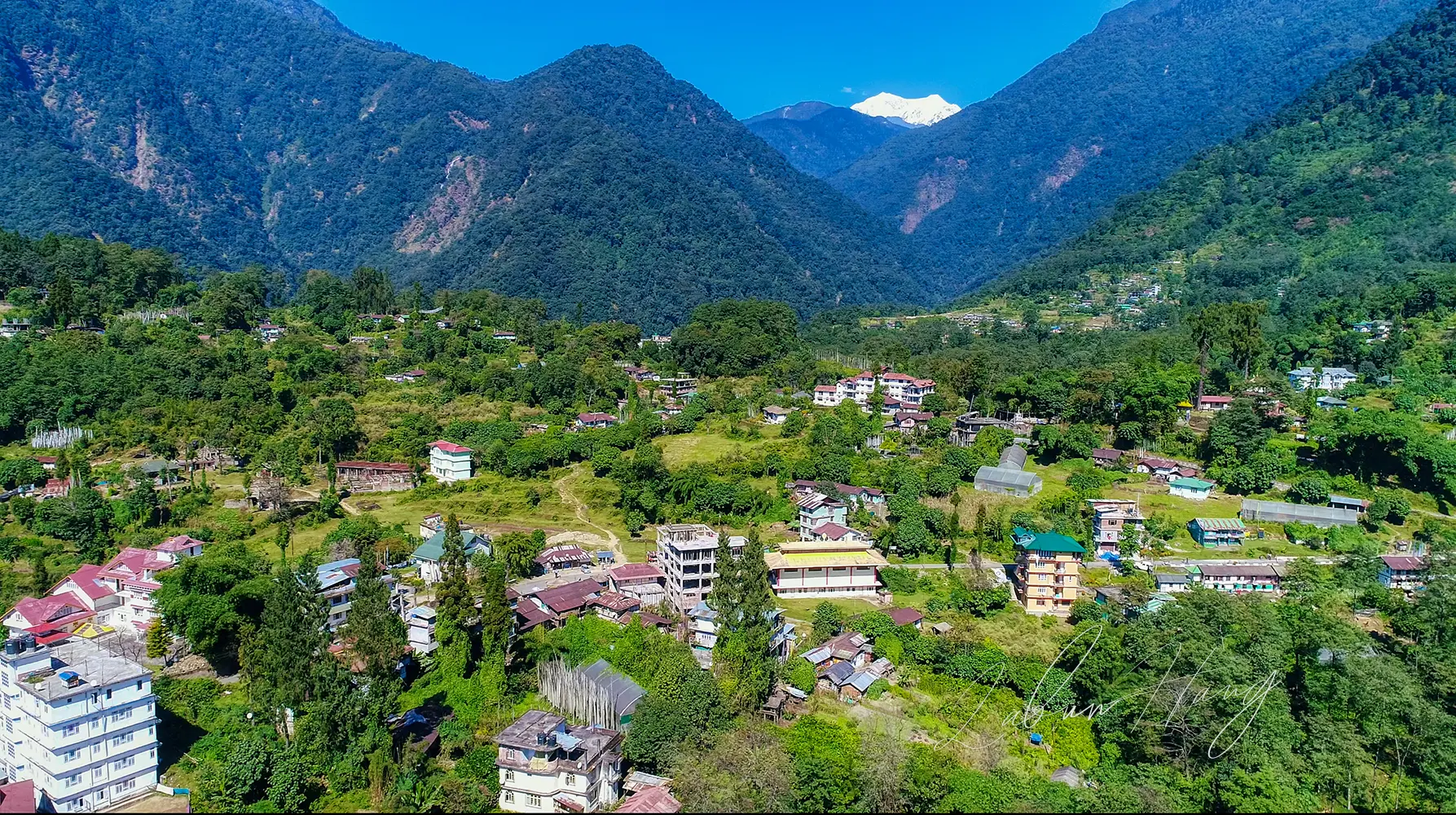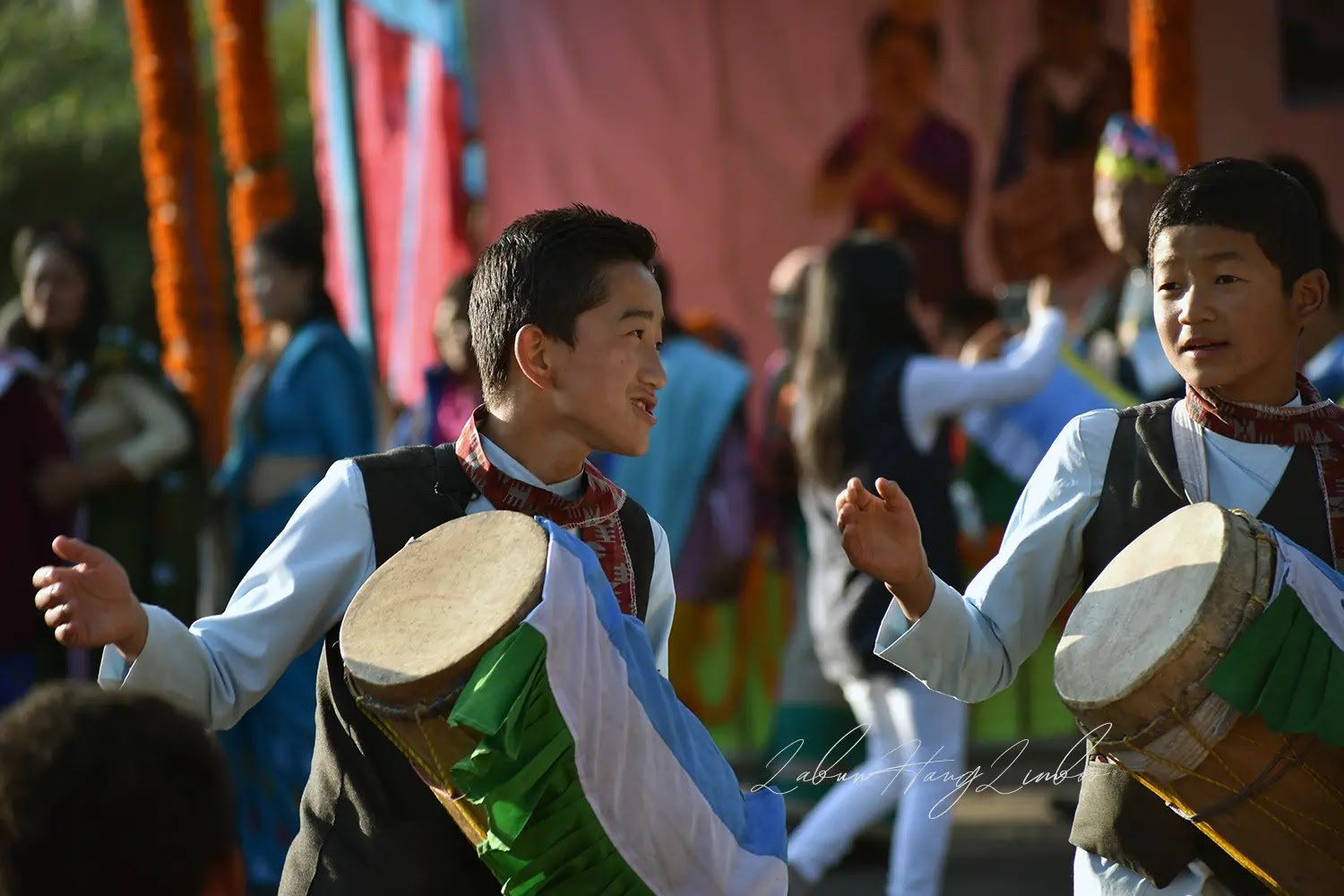Sewaro, Khamree Mo, Tashi Delek, Namaskaar. I am writing this article for you from the soil of my home in Yuksom — yes, the very village where Sikkim’s first king was crowned over 380 years ago.
When you grow up in a place where history breathes with the wind and the mountains hold secrets older than any book, it shapes your entire view of the world.
I am Labun Hang Limboo, and I belong to Tsong “Limboo”, one of the Indigenous community of Sikkim.
I was born and raised in Yuksom, a quiet town tucked into the green heart of Sikkim’s west district. To many outsiders, Yuksom appears as little more than a starting point for the famous trek to Dzongri or Goecha La.
But for those of us who call this land home, it is so much more than a trailhead. It is sacred ground. It is the birthplace of our kingdom and the very soul of Sikkim’s spiritual and political identity.
I still remember the first time I truly understood what Yuksom meant. I must have been five or six years old when my parents took me on a walk to Norbugang Chorten and the nearby Kathok Lake. We strolled past the fluttering prayer flags, and then they pointed to a simple stone throne beneath a canopy of pine trees. My father said, “This is where the first king of Sikkim was crowned.” I stood there quietly, trying to imagine the moment. Since that day, I have carried that history with me like a second heartbeat.
Yuksom is the sacred origin of a kingdom, a living museum of Tibetan Buddhism, and the door to some of the most spectacular Himalayan treks on Earth. When you visit us, you are not just passing through tourist spots. You are walking across the very foundations of Sikkimese identity, culture, and faith.
What is Yuksom?
Yuksom ; it is the very soil where Sikkim’s story begins.
The name “Yuksom” means “the meeting place of the three wise monks.” That moment in history refers to the arrival of three revered lamas who came together here in 1642 AD to consecrate the first king of Sikkim. This small, peaceful settlement in West Sikkim went on to become the first capital of the kingdom, marking the spiritual and political birth of Sikkim itself.
To those who visit, Yuksom may appear to be a quiet village surrounded by lush green valleys and forested hills. But for us who belong here, it is sacred ground. It is where faith, monarchy, nature, and identity came together centuries ago. Even today, our traditions, our festivals, and the rhythm of life are deeply tied to that legacy.
Located at the edge of the Khangchendzonga National Park, Yuksom is often described as the gateway to Mount Kanchenjunga. It is from here that legendary Himalayan treks begin, including the Dzongri and Goechala routes. But before the trekking boots step onto alpine trails, they pass through monasteries, lakes, and stories older than written history.
Beyond its historical and natural significance, Yuksom is also one of the few towns in Sikkim officially recognised as a model village for sustainable tourism. The community here actively protects the environment and cultural heritage through conservation work, responsible tourism practices, and by maintaining the authentic rhythm of village life.
Yuksom was the first town in Sikkim to ban plastic bags.
Among the Bhutia community and local Buddhist practitioners, Yuksom is also known by another name — Demazong, the “valley of rice.” It was once a prosperous settlement renowned for its abundance and fertility, both in crops and culture.
Yuksom is a place of beauty; it is sacred, surreal, and significant. It is a place that continues to live its history rather than simply remembering it.
Yuksom’s Rich History and Cultural Significance
Before the Kingdom: Indigenous Roots of Yuksom
Long before Yuksom became the birthplace of Sikkim’s monarchy, Sikkim was the ancestral home of the Lepchas and Limbus—the Rong and Tsong. These Indigenous communities followed animistic traditions rooted in nature. They lived by oral law, worshipped mountain deities, and preserved harmony through sacred lakes, stone altars, and clan governance. While their practices predate Buddhist influence, these beliefs continue in parallel to this day.
The political establishment of 1642 brought Buddhist authority into the region, but the deeper rhythms of the land — its sacred groves, its ancestral deities, and its farming wisdom — continued to exist alongside the new spiritual order. This truth is rarely mentioned in official tourism literature, but as someone who belongs to the Limboo (Tsong) community, I believe it must be acknowledged clearly.
The Birthplace of Sikkim’s Monarchy
The pivotal moment that placed Yuksom on the historical map of the Eastern Himalayas occurred in 1642 AD, when three Tibetan lamas — Lhatsun Namkha Jigme, Sempa Chembo, and Rinzing Chembo — journeyed from different directions to this valley. They came with the intention of fulfilling a prophecy: to find a just and spiritually worthy leader and consecrate him as the ruler of a unified land called Denzong — the hidden valley.
They selected Phuntsog Namgyal, a man of noble Bhutia descent with links to the earlier Minyak dynasty of Tibet. He was crowned as the first Chogyal, or Dharma King, of Sikkim at Yuksom. This event marked the formal founding of the Namgyal dynasty, which ruled Sikkim for 333 years, until Sikkim became the 22nd state of India in May 1975 after a public referendum.
The Coronation Site: Norbugang Throne
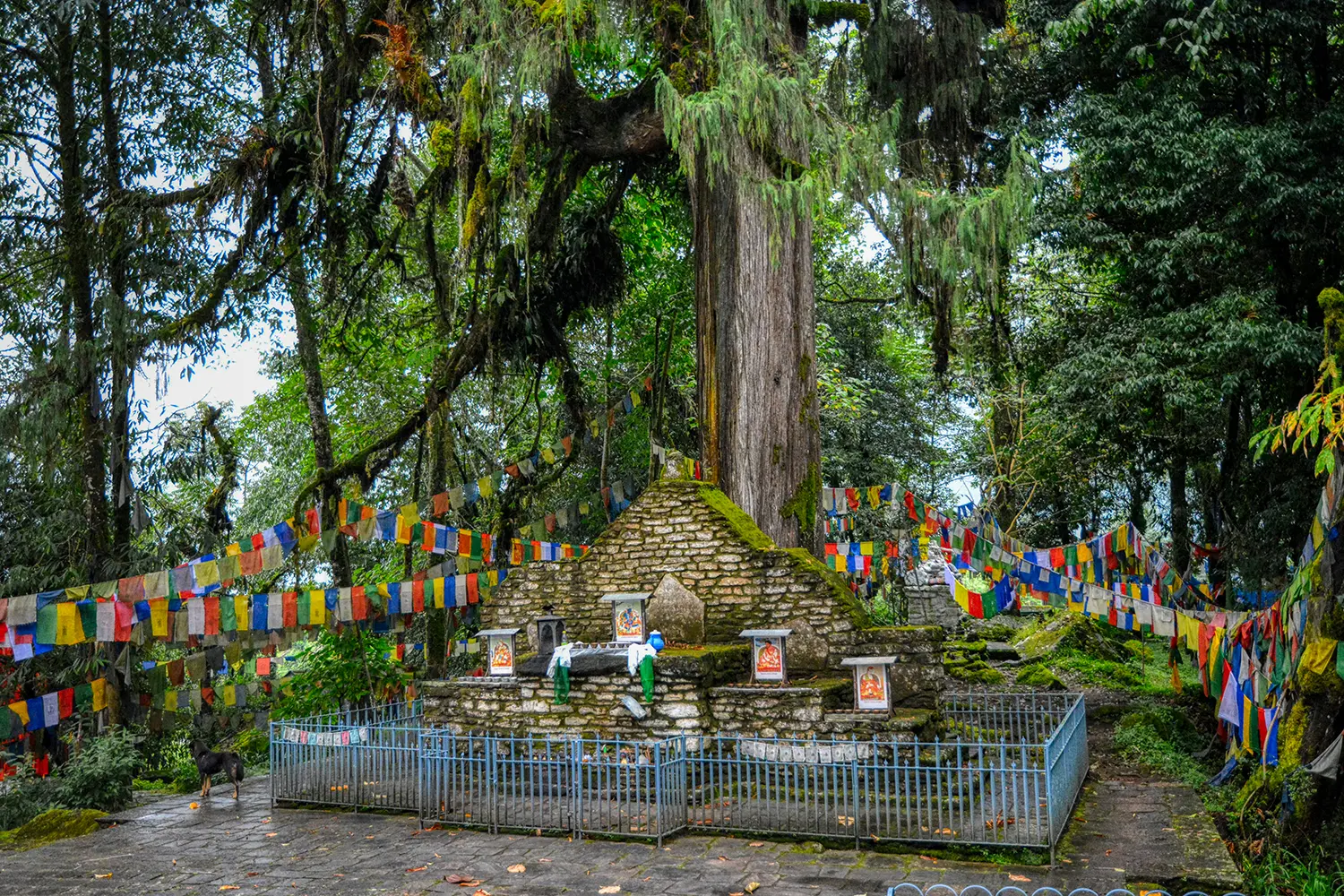
The coronation took place at what is now known as Norbugang, a sacred site in the heart of Yuksom. The actual throne — a stone platform surrounded by smaller stone seats — still stands today. There are four seats carved out: one for each of the three lamas, and one for the king.
A flat rock nearby bears what is believed to be a footprint of Lhatsun Namkha Jigme, imprinted during the ritual consecration.
Beside the throne stands the Norbugang Chorten, a stupa said to be filled with soil and water collected from all parts of Sikkim — symbolising unity, not conquest. These elements were gathered by the lamas themselves or brought by their followers, further reinforcing the sacredness of the event.
Overlooking the complex is a tall pine tree, believed to be over 380 years old and present since the day of the coronation.
Today, the entire site is preserved as part of Norbugang Park and is protected by the Archaeological Survey of India (ASI).
Dubdi Monastery (Yuksom Monastery)
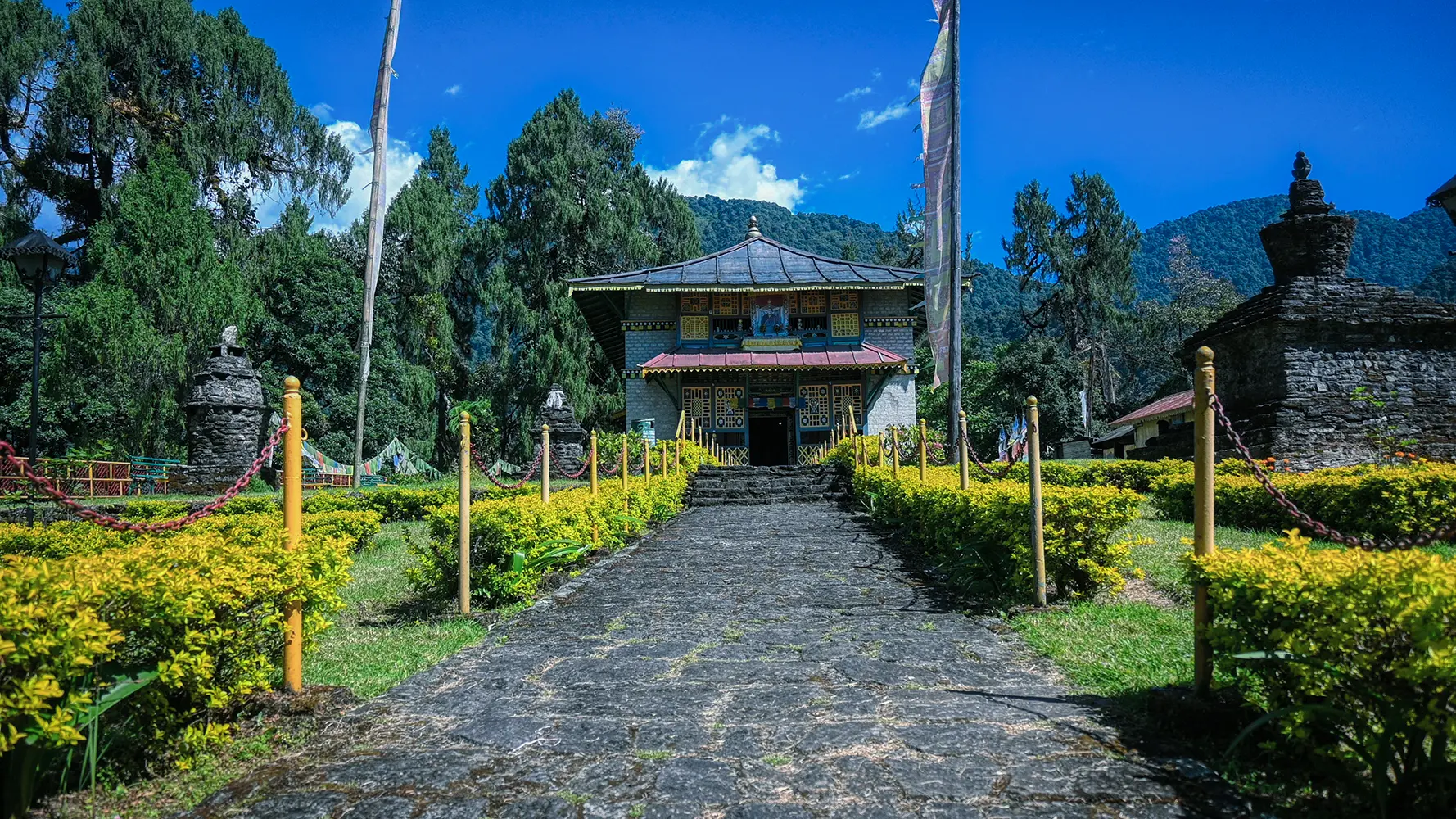
Shortly after the coronation, the first monastery of the new kingdom was constructed on a ridge above Yuksom. Named Dubdi, meaning “The Retreat,” it was established in either 1647 or 1701 — historical records vary — and dedicated to Lhatsun Namkha Jigme.
Dubdi is part of the Nyingma school of Tibetan Buddhism, one of the oldest of the four major schools.It became an important seat of meditation and spiritual training during the early consolidation of the kingdom. Located about 3 kilometres uphill from the village, the path goes through forests of rhododendron, oak, and maple.
On clear days, visitors at Dubdi can view Mount Pandim, Kabru North, and even distant glimpses of the Kanchenjunga range — peaks considered sacred by both Buddhists and the indigenous communities.
The monastery was damaged in the 2011 Sikkim earthquake but has since been restored. It is not open every day, and many local pilgrims choose to offer prayers outside the main gate when it is closed.
Dubdi remains as part of the spiritual backbone of Yuksom, and for many, it represents the successful blend of religious philosophy and natural retreat.
Other Monasteries and Religious Sites
Kartok Monastery
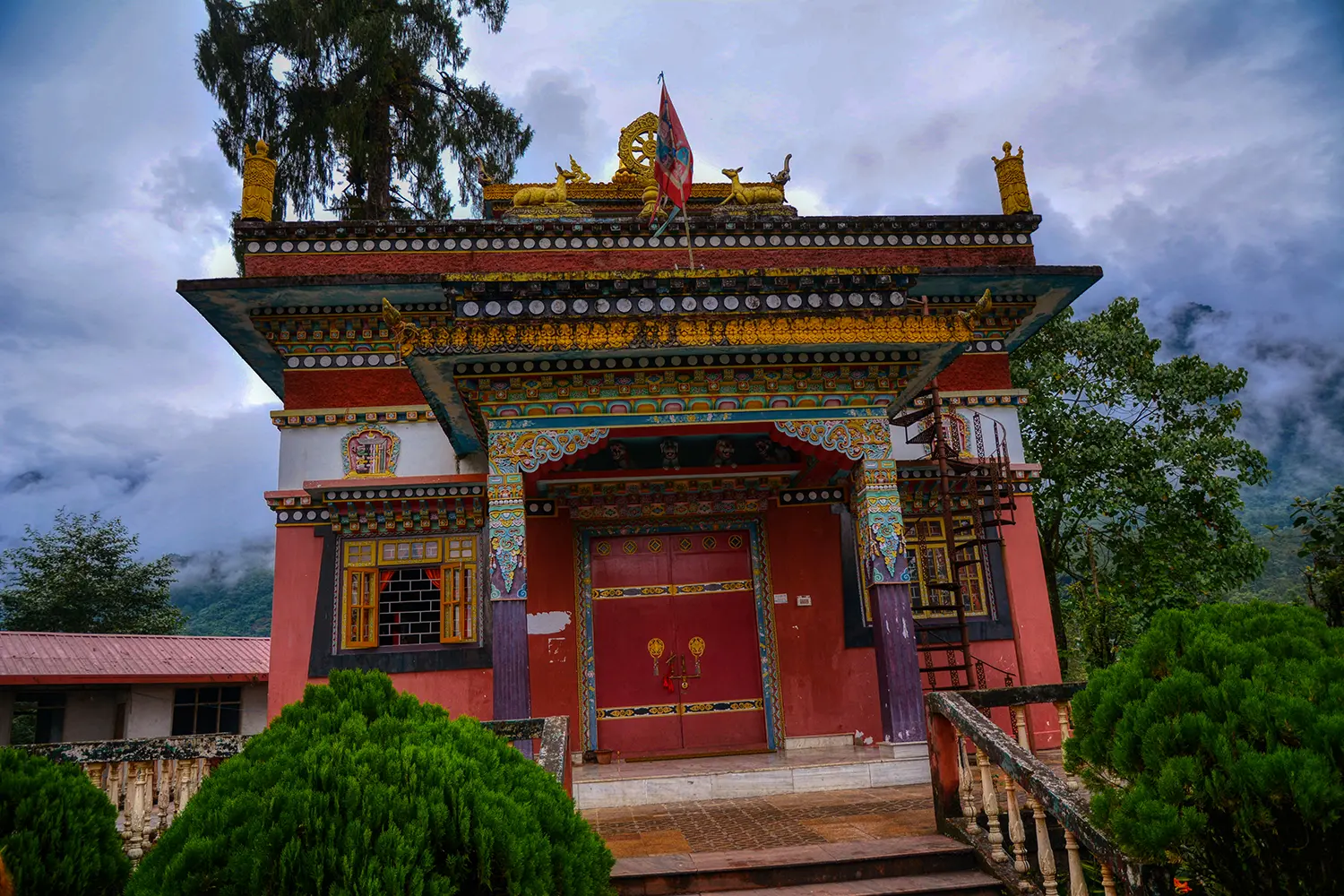
Situated opposite Kathok Lake, Kartok Monastery is noted for its majestic entrance and intricately painted wooden architecture. It is named after Lama Kathok Kuntu Zangpo and is one of the three most important monasteries forming Yuksom’s religious circuit.
Mani Hall
Located in the town center, the Mani Hall is a unique glass-walled sacred place, that houses eighteen large, decorated prayer wheels. It is a place where school children, the elderly, and travelers alike come to meditate and spin the wheels in silence. This hall is part of everyday spiritual rhythm in Yuksom.
Tashiding Monastery
About 19 kilometres from Yuksom lies Tashiding Monastery, one of the most spiritually significant sites in all of Sikkim. It was established in 1641 by Ngadak Sempa Chembo Phunshok Rigzing, one of the three coronation lamas.
Perched on a hilltop at the confluence of the Rathong and Rangeet rivers, it is best known for hosting the Bumchu Festival. During this event, a sacred urn is opened once a year, and the level of water inside is used to predict the year’s fortune.
Tashiding is often called the “Heart of Denzong” and is deeply connected to Yuksom through shared lineage and spiritual geography.
Kathok Lake (Karthok Lake)
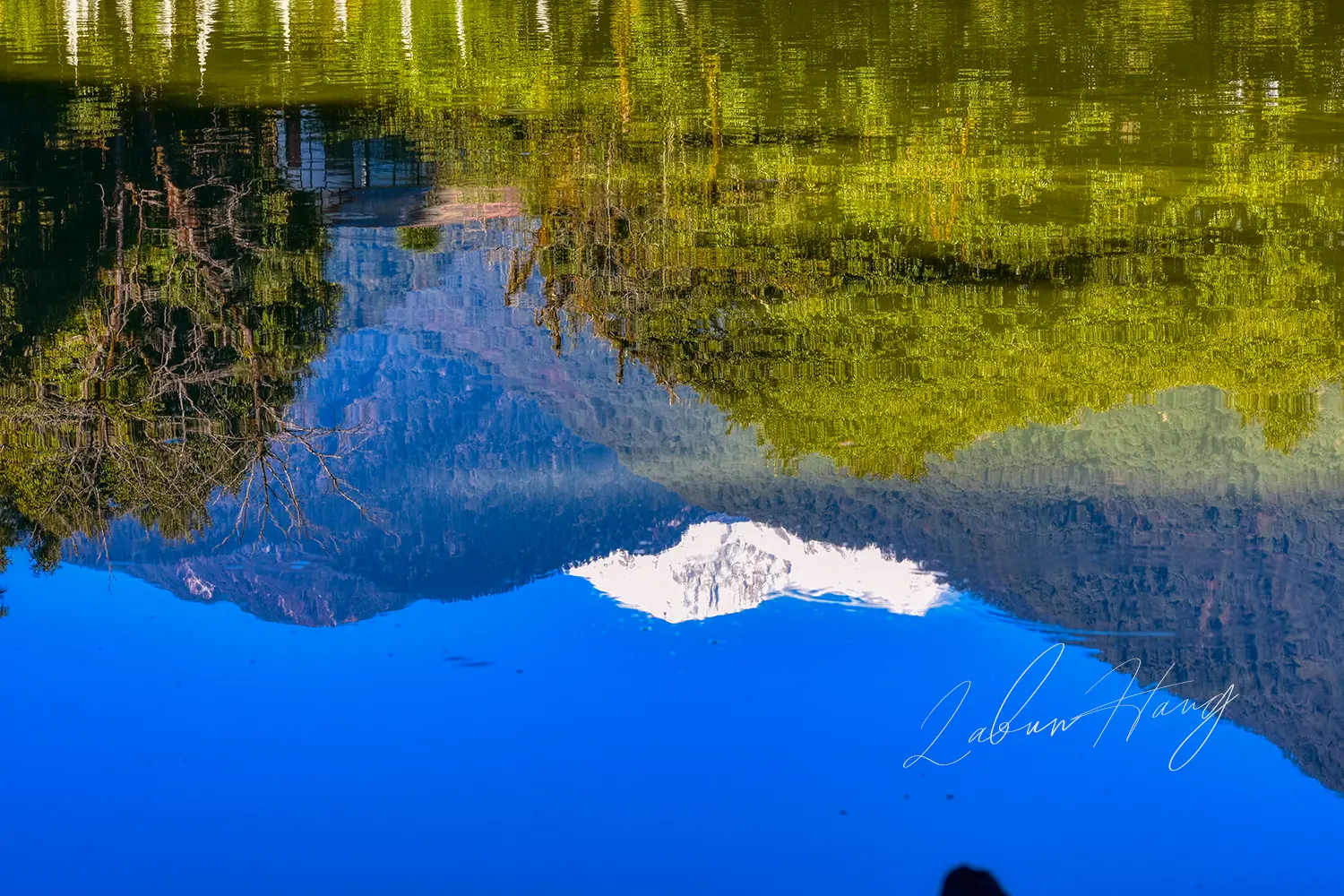
Kathok Lake is considered the “soul pool” of Lama Kathok Kuntu Zangpo. It holds special significance for the Bhutia community of Yuksom. It is said that sacred water used during the coronation of the first Chogyal was drawn from this lake. Every year, lamas and locals gather here to make offerings and prayers.
Khecheopalri Lake
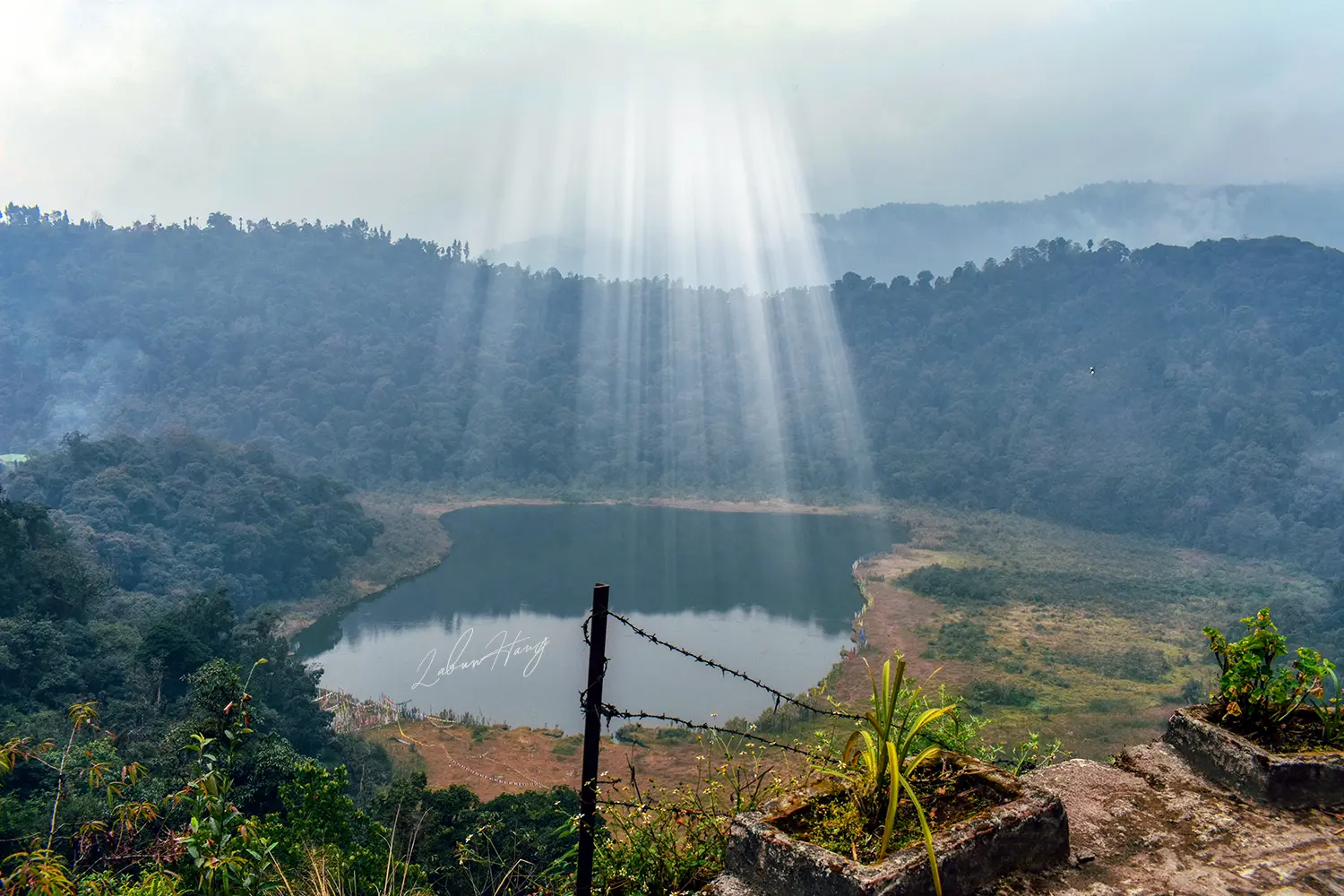
Khecheopalri Lake, located farther away from Yuksom but often included in pilgrimage routes, is holy to both Buddhists and Hindus. It is shaped like a footprint and believed to fulfill wishes. A rare phenomenon associated with the lake is that no leaf is ever seen floating on its surface — birds are observed to pick them off, a sight regarded by devotees as a sign of divine presence.
Broader Cultural Context
Yuksom is spiritually and culturally significant to the local communities. While the monasteries showcase the visible face of Buddhism, the older layers of indigenous identity continue through oral tradition, seasonal rituals, and nature worship.
Symbolically, Yuksom is believed to represent the “third eye” among four sacred sites blessed by Guru Padmasambhava. This connection ties it to a broader sacred geography in the Himalayan Buddhist world.
Even today, walking the path between Norbugang and Kartok Monastery, I see prayer wheels on one side and old trees adorned with stone and leaves on the other. Both are part of the same sacred continuum.
Things to Do in Yuksom: Beyond the Treks
While many visitors journey to Yuksom specifically for its famous trekking routes, this charming West Sikkim destination offers an abundance of experiences that showcase both natural splendor and cultural richness. From ancient monasteries perched on hillsides to pristine waterfalls cascading through dense forests, Yuksom presents travelers with diverse opportunities to immerse themselves in authentic Himalayan culture and breathtaking landscapes.
Tashi Tenka Panoramic Views :
Once home to Sikkim’s royal family, the Tashi Tenka site now serves as one of the region’s most spectacular viewpoints. Though the original palace structures have weathered with time, visitors can explore the remaining foundations while enjoying sweeping vistas of the Himalayan ranges, including clear views of the Rathong Valley and distant monastic complexes. Photography enthusiasts particularly appreciate this location during dawn hours when the morning light illuminates the mountain peaks in golden hues.
Kanchenjunga Falls and Sacred Khechoperi Lake Circuit
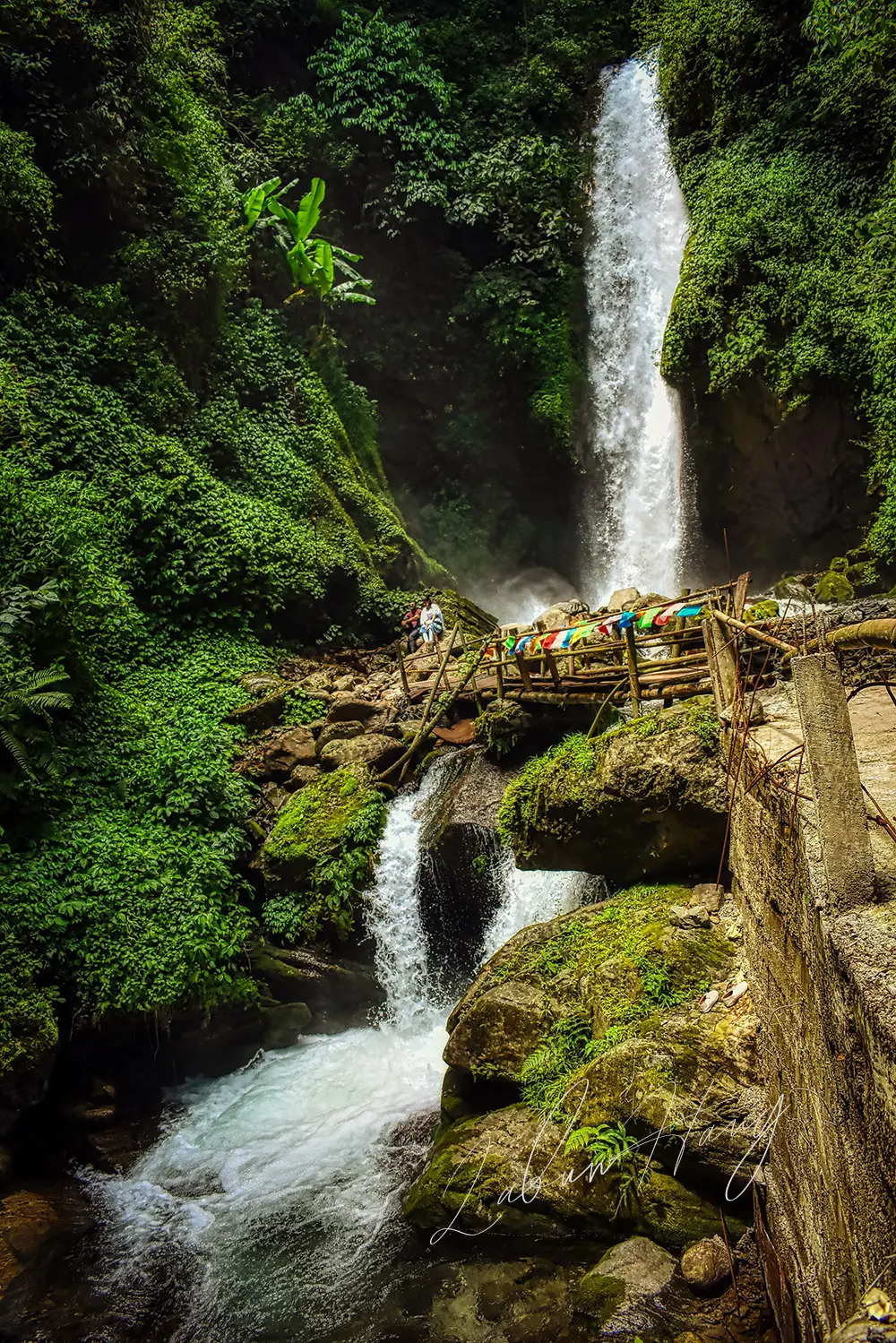
This popular day excursion combines two of West Sikkim’s most celebrated natural attractions. The Kanchenjunga Falls present a dramatic multi-tiered cascade system, where visitors can ascend stone pathways to various viewing platforms. Each level offers unique photographic opportunities and different perspectives of the falling water.
The sacred Khechoperi Lake, revered by both Hindu and Buddhist communities, maintains its pristine condition through a remarkable natural phenomenon – local bird species instinctively remove fallen leaves from the water’s surface. Pilgrims and tourists alike come here to make wishes, believing in the lake’s spiritual powers.
The journey between these two attractions can be accomplished either through guided forest walks or comfortable vehicle transport, with local food vendors providing regional snacks at both destinations.
Norbugang Heritage Park Evening Walks
This beautifully maintained park surrounds the historically significant coronation site where Sikkim’s monarchy began over three centuries ago. Ancient prayer flags flutter in the mountain breeze while a centuries-old Cryptomeria pine tree stands as a living witness to the kingdom’s founding ceremony. The park features traditional Buddhist structures including prayer wheels and stupas, creating a serene atmosphere perfect for contemplation and cultural appreciation.
Village Discovery Expeditions
The surrounding rural communities offer visitors glimpses into authentic Himalayan life, where traditional architecture blends harmoniously with stunning natural settings. These settlements showcase the region’s multicultural heritage, with Limboo, Bhutia, Nepali, and Lepcha families maintaining their distinct customs while living as neighbors. The village helipad provides exceptional 360-degree valley panoramas, while walking paths wind through terraced fields and traditional homes that seem transported from European alpine regions.
Avian Bird Watching Destination
Positioned at the gateway to Kanchenjunga National Park, Yuksom attracts numerous Himalayan bird species throughout the year. Early morning expeditions reveal diverse wildlife including Grey Treepies, Himalayan Bulbuls, colorful sunbird varieties, and occasionally rare species like the Satyr Tragopan. Prime observation locations include the monastery trail approaches, lake peripheries, and traditional homestay gardens where native vegetation attracts varied bird populations.
Optimal Birding Conditions:
- Dawn excursions between 6:00-8:00 AM yield best results
- Spring months (March-May) offer peak activity periods
- Autumn seasons (October-November) provide clear visibility
- Binoculars and subdued clothing enhance wildlife viewing success
Explore Phamrong Waterfall
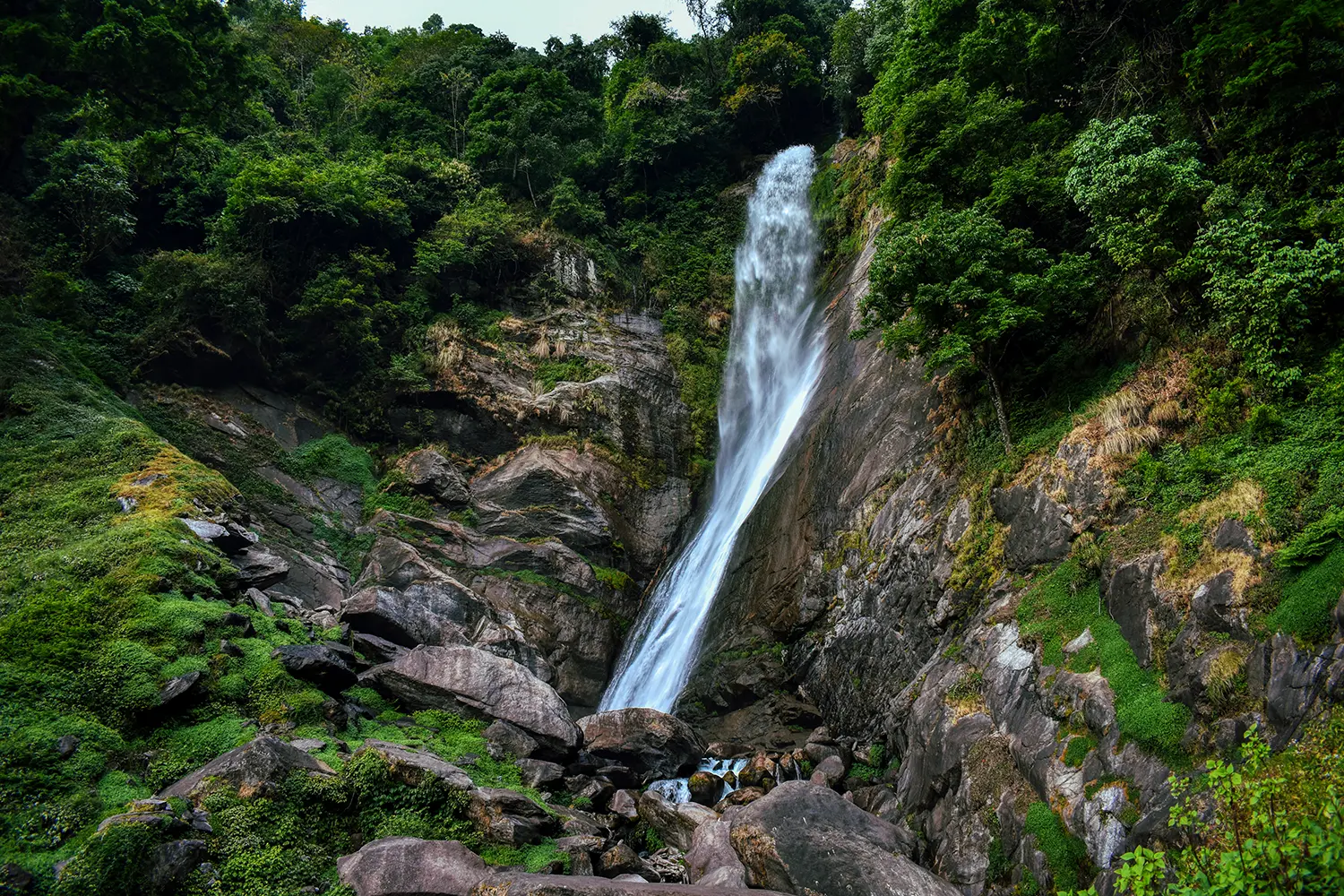
Located seven kilometers from central Yuksom along the Tashiding route, Phamrong represents one of West Sikkim’s most impressive natural water features. Dense forest surroundings and steep rocky cliffs frame this powerful cascade, which reaches maximum intensity during post-monsoon periods. Well-maintained trails with rest stations allow visitors to approach the falls safely while enjoying forest scenery and mountain views.
Yeba Rock Climbing Adventures
Adventure seekers can test their skills on Yeba Rock, named after legendary Limboo shamanic traditions. This natural climbing formation offers routes suitable for various experience levels, from novice climbers to seasoned mountaineers. Professional guides ensure safety while participants enjoy panoramic valley vistas from elevated positions. Morning climbing sessions provide optimal conditions with cooler temperatures and better rock grip.
Cultural Immersion and Culinary Discoveries
Local establishments throughout Yuksom serve traditional cuisine prepared using centuries-old techniques and indigenous ingredients. Family-run kitchens welcome visitors to sample genuine mountain flavors, often featuring organic produce grown in nearby terraced fields and traditional preservation methods passed down through generations.
Yak Cheese and Tibetan Bread Tastings
This unique dairy product, crafted from high-altitude yak milk, offers distinctive flavors and superior nutritional content compared to conventional cheese varieties.
The slightly smoky texture pairs excellently with traditional Tibetan bread (Balep), which undergoes overnight fermentation before being shaped into flatbreads and cooked with local butter. This combination represents authentic Himalayan mountain cuisine at its finest.
Local Market Immersion
Yuksom’s central bazaar provides authentic interaction opportunities with local vendors and residents. Traditional handicrafts, locally grown produce, and regional specialties fill small shops built on stilts, creating a vibrant marketplace atmosphere. Street food vendors offer quick tastes of Sikkimese flavors while artisans display handcrafted items perfect for meaningful souvenirs.
Traditional Dish Exploration
Rice and Lentil Combinations (Dal-Bhaat-Curry): The foundation meal throughout Sikkim, featuring perfectly seasoned lentils served with steamed rice and traditional curry preparations.
Fermented Vegetable Preparations (Gundruk): Ancient preservation techniques transform leafy greens into tangy, probiotic-rich accompaniments that enhance digestion and provide essential nutrients during harsh mountain winters.
Festival Rice Treats (Sel Roti): Ceremonial deep-fried rice circles with crispy exteriors and tender centers, traditionally prepared during celebrations and served alongside spiced potato preparations.
Dumpling Varieties (Momos): Steam-cooked or pan-fried parcels filled with seasoned vegetables or meat, accompanied by spicy tomato-based dipping sauces that provide perfect flavor balance.
Noodle Soup Comfort (Thukpa): Warming broth-based dishes featuring handmade noodles, seasonal vegetables, and aromatic spices that provide comfort after mountain adventures.
Artisanal Cheese Products (Chhurpi): Rock-hard cheese preparations that soften when added to hot soups or can be enjoyed as protein-rich snacks during extended outdoor activities.
Fermented Root Vegetables (Sinki): Traditional preservation techniques transform radish roots into flavorful condiments through months-long fermentation processes.
Cooking Workshop Participation
Many local families offer hands-on cooking instruction where visitors learn traditional preparation methods for authentic Sikkimese dishes. These intimate sessions reveal ancient ingredient combinations, fermentation techniques, and cooking methods using traditional utensils and wood-fired stoves.
Extended Adventure Opportunities
Pelling Day Excursions
A comfortable two-hour journey leads to Pelling’s renowned attractions, including the innovative glass skywalk offering dramatic valley perspectives, ancient monastery complexes with intricate Buddhist artwork, historical palace ruins accessible through forest trails, and specialized bird sanctuaries housing over 200 regional species.
Hidden Monastery Pilgrimages
Full-day expeditions to remote Hung Hri Monastery traverse cardamom cultivation areas and traditional Lepcha settlements. These moderate difficulty hikes require experienced local guides who share oral histories and legends not documented elsewhere, providing deep cultural insights into Sikkim’s spiritual heritage.
Cultural Exchange Sessions
Informal tea gatherings with local residents offer opportunities to learn regional folklore, understand traditional beliefs, and appreciate the historical significance of various sacred sites. These authentic interactions provide perspectives unavailable through conventional tourism experiences.
Yuksom’s diverse offerings ensure that every visitor discovers meaningful connections with this remarkable Himalayan destination, whether through spiritual exploration, natural wonder appreciation, cultural immersion, or adventurous outdoor pursuits. The town’s commitment to sustainable tourism practices preserves these treasures while providing authentic experiences that create lasting memories.
Trekking Adventures from Yuksom: Gateway to the Himalayas
Yuksom, the historic capital of Sikkim, is more than just a scenic village. It is the starting point of some of the most iconic high-altitude treks in India. Nestled at the base of the Kanchenjunga range, Yuksom connects modern-day trekkers to sacred trails, rich biodiversity, and Himalayan legends.
Goecha La Trek – Top Trekking in Sikkim
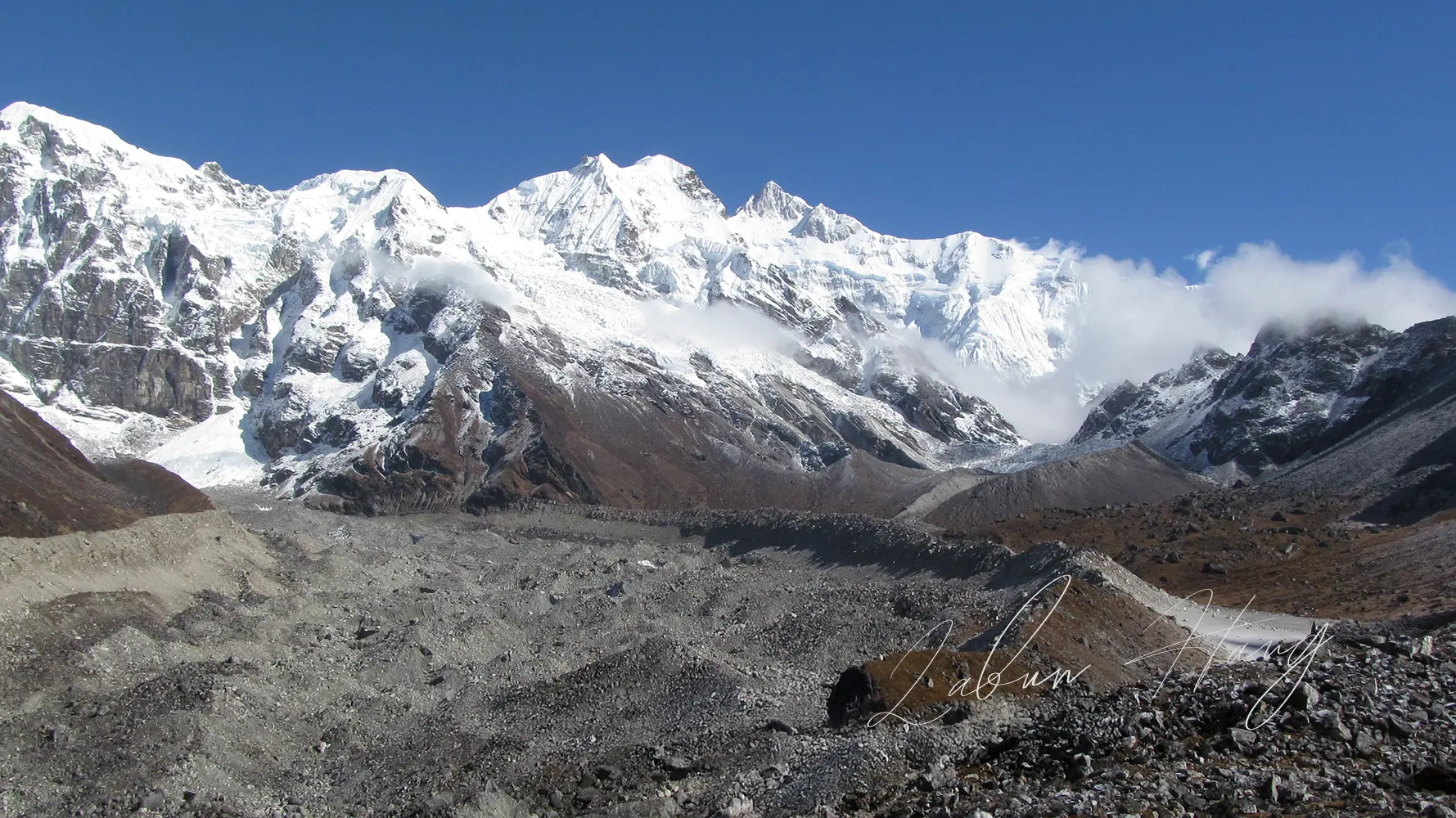
Widely regarded as Sikkim’s most spectacular trek, the Goecha La Trek offers unmatched views of Mount Kanchenjunga. Over 8 to 10 days, this trail cuts through lush forests, blooming rhododendron groves, alpine meadows, and glacial terrain, ending at Goechala Pass (16,200 ft / 4,938 m).
The final permitted point on the Goecha La Trek lies at 4,600 meters, offering an unforgettable close-up view of Mount Kanchenjunga, the world’s third-highest peak.
Trek Itinerary:
- Day 1: Yuksom to Sachen (2,195 m) – Rainforest trail with hanging bridges
- Day 2: Sachen to Tshoka (2,900 m) – Rhododendron forests and altitude gain
- Day 3: Tshoka to Dzongri (4,020 m) – Steep ascent into alpine meadows
- Day 4: Rest day + hike to Dzongri Top (4,170 m) – Panoramic sunrise over 14 peaks
- Day 5: Dzongri to Thansing (3,940 m) – Long descent and riverside trail
- Day 6: Thansing to Lamuney (4,200 m) – Short walk before the final summit push
- Day 7: Lamuney to Goechala Viewpoint 1 and return to Kokchurung – Max altitude: 4,600 m
- Day 8: Thansing to Kokchurung (3,720 m) – Scenic descent
- Day 9: Kokchurung to Tshoka
- Day 10: Tshoka to Yuksom – Trek completion
Difficulty: Moderate to challenging
Distance: Approx. 73 km
Best Time: March to May and September to December
Cost:
- Indians: ?18,000 to ?25,000
- Foreigners: USD $450 to $650
Inclusions: Accommodation, permits, meals, camping gear, guide, porters, oxygen, basic first aid
Exclusions: Tips, personal porter, personal gear, travel insurance, transportation
Recommended Packing Essentials:
- Down jacket, thermals, rain gear, quick-dry layers
- Waterproof trekking boots, gloves, trekking poles
- Sleeping bag (sub-zero rated), headlamp, sunglasses, sunscreen
- Water purification tablets, snacks, first-aid kit
Other Popular Treks from Yuksom
Dzongri Trek
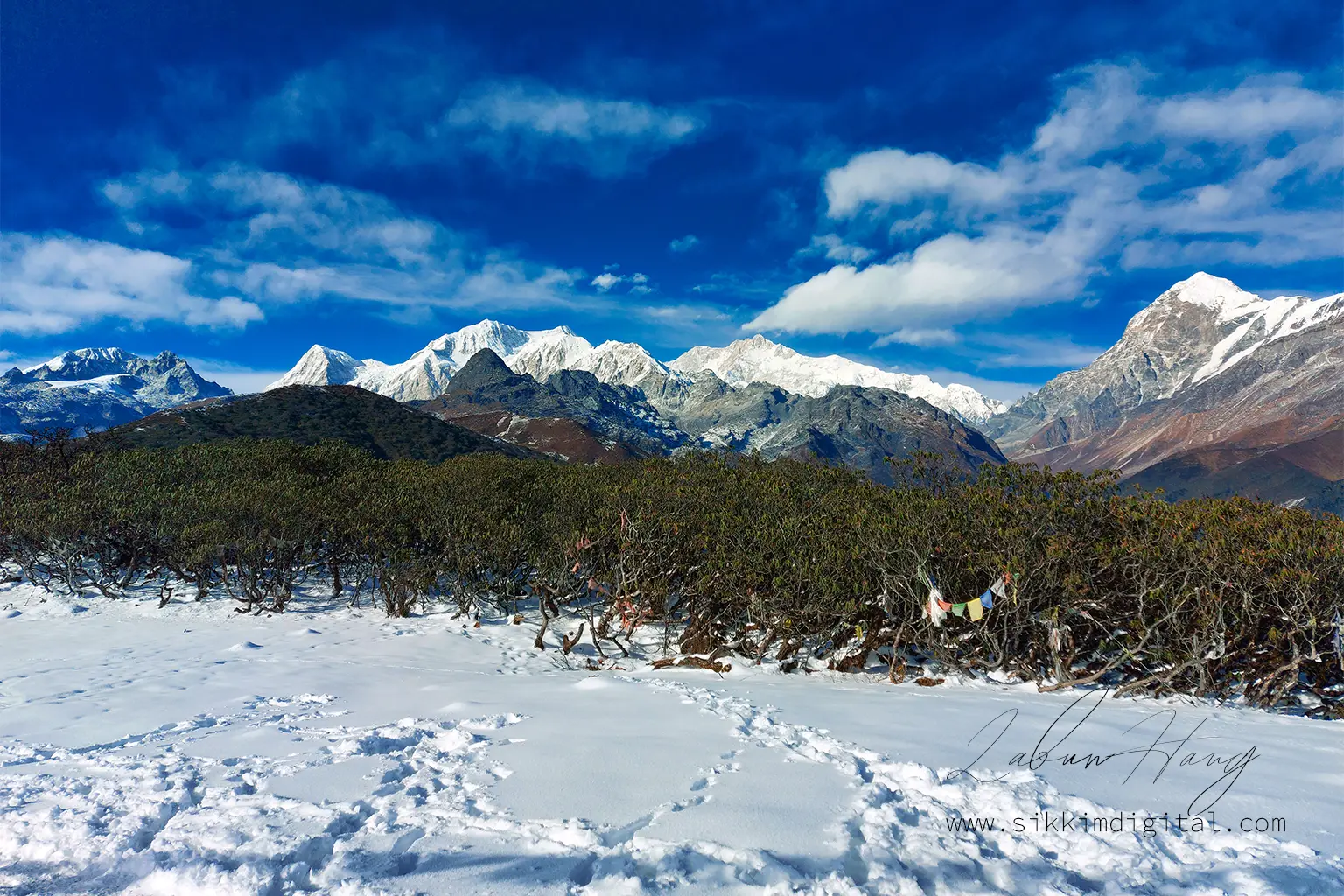
Ideal for beginners and short on time, this 8-day trek reaches Dzongri Top (4,170 m). It follows the same trail as Goechala for the first few days but turns back after Dzongri.
Duration: 8 days
Grade: Moderate
Best for: First-time high-altitude trekkers
Mt. Thinchenkhang Climbing Expedition
A 17-day challenge for seasoned mountaineers, peaking at 6,010 m (19,700 ft). Requires technical climbing skills.
Grade: Highly Challenging
Highlights: Ice axe work, summit training, and rare views of Kanchenjunga and Nepal peaks
Goechala Kasturi Circuit Trek
An extended 12-day loop combining remote wilderness, wildlife, and solitude. Ideal for trekkers wanting to go beyond the main route.
Grade: Moderate Plus
Specialty: Offbeat trail, lesser crowd, wildlife-rich zones
Singalila–Goechala Circuit Trek
This 16-day trek is the most comprehensive Himalayan journey from Yuksom. It covers multiple valleys and culture-rich villages, ending in Yuksom.
Grade: Moderate Plus
Best for: Experienced trekkers seeking variety in landscape and cultural immersion
Yuksom: Base Camp for Himalayan Mountaineering Institute
Yuksom is also the official base for the Himalayan Mountaineering Institute’s expeditions to Mount Kanchenjunga. Advanced climbing courses, instructor-led summits, and technical expeditions frequently begin here, making it a professional hub for mountaineers across India.
Kanchenjunga National Park: A UNESCO World Heritage Wonder
Your trekking adventures take place within the extraordinary Kanchenjunga National Park, which holds the prestigious distinction of being India’s first UNESCO World Heritage Site recognized for both natural and cultural significance.
UNESCO World Heritage Recognition
In 2016, Kanchenjunga National Park became India’s first “Mixed Heritage” site, acknowledging both its incredible natural biodiversity and deep cultural importance to local communities. This recognition places it among the world’s most significant protected areas, alongside famous sites like Yellowstone and the Galápagos Islands.
The park covers an remarkable 849 square kilometers and showcases one of the widest altitudinal ranges of any protected area worldwide – from 1,220 meters to 8,586 meters above sea level.
Extraordinary Biodiversity
Endangered Mammal Species:
- Snow Leopards: The park protects crucial habitat for these elusive big cats, considered the ultimate prize for wildlife photographers
- Red Pandas: Sikkim’s state animal thrives in the park’s bamboo forests and temperate woodlands
- Himalayan Black Bears: These powerful omnivores roam the park’s diverse forest ecosystems
- Blue Sheep (Bharal): High-altitude specialists perfectly adapted to rocky mountain terrain
Incredible Bird Diversity: The park provides habitat for nearly half of India’s total bird species, including:
- Blood Pheasant and Satyr Tragopan
- Himalayan Monal with brilliant iridescent plumage
- Over 550 recorded bird species across various altitudes
- Numerous endemic Himalayan species found nowhere else
Unique Forest Ecosystems:
- Krummholz Forests: Twisted, wind-sculpted trees at high altitudes create otherworldly landscapes
- Ancient Rhododendron Groves: Some of the world’s largest rhododendron trees flourish here
- Temperate Oak and Birch Woodlands: These forests support incredible biodiversity
- Alpine Meadow Systems: High-altitude grasslands burst with wildflowers during growing seasons
Sacred Mountain Traditions and Spiritual Significance
Mount Kanchenjunga holds profound spiritual meaning for local communities, who have protected this mountain for generations through traditional beliefs and practices. Local people consider the peak home to powerful mountain spirits, which is why mountaineering expeditions traditionally stop short of the actual summit as a mark of respect.
Traditional Beliefs:
- The mountain serves as the dwelling place of protective deities
- Sacred lakes, caves, and rock formations throughout the park hold religious significance
- Ancient Buddhist and pre-Buddhist traditions continue to guide conservation efforts
- Local communities maintain spiritual practices that naturally protect wilderness areas
Cultural Heritage Protection: The park preserves not only natural ecosystems but also traditional knowledge systems, spiritual practices, and cultural sites that have existed for centuries. This integration of conservation and culture makes Kanchenjunga unique among world heritage sites.
Living Heritage: Unlike many protected areas that exclude human communities, Kanchenjunga National Park recognizes the important role local people play in conservation. Traditional practices and spiritual beliefs have successfully protected this landscape for generations, making it a model for community-based conservation worldwide.
This extraordinary combination of natural wonders and cultural significance makes every trek from Yuksom not just an adventure, but a journey into one of the world’s most important and sacred landscapes. Whether you choose the challenging Goechala route or opt for shorter explorations, you’ll be walking
Planning Your Trip to Yuksom:
Successfully planning your Yuksom adventure depends on choosing the right season and understanding basic logistics. This essential guide covers the key factors that will make or break your Himalayan experience.
Best Time to Visit Yuksom
March to May: Spring in the Himalayas
Spring is when Yuksom begins to wake up from its winter hush. From late March onward, rhododendrons bloom across the trails, filling the forests in shades of red, white, and pink. The daytime temperature ranges between 12°C and 20°C, making it comfortable for hikes, monastery visits, and outdoor photography.
Why visit in spring:
- Rhododendron season: Hills and forests come alive with floral color, especially along the Goechala and Dzongri trails.
- Stable weather: Minimal rainfall and clear skies mean reliable visibility of the Kanchenjunga range.
- Trekking season begins: High-altitude routes open up after winter snow, making it the ideal time for the Goechala Trek or a shorter Dzongri La Trek.
- Best for sightseeing: Places like Tashi Tenka, Dubdi Monastery, and the Coronation Throne are easier to access without weather disruption.
September to Mid-December: Post-Monsoon Clarity
Autumn is the most sought-after season for serious trekkers and photographers. The monsoon washes away the dust and haze, leaving behind crystal-clear skies and dramatic mountain views.
From late September through early December, Yuksom enjoys dry, crisp air, making it ideal for adventure travel and wildlife spotting.
Why autumn is ideal:
- Unmatched visibility: The peaks of Kanchenjunga, Kabru, and Pandim are visible in their full glory — a dream for photographers.
- Wildlife activity peaks: With animals preparing for winter, Khangchendzonga National Park becomes a hotspot for birdwatching and rare sightings.
- Cool and steady climate: Expect clear days, low humidity, and average daytime temperatures between 10°C to 18°C.
- Longer trekking window: Autumn conditions are ideal for extended treks like the Kasturi Circuit and Singalila–Goechala Circuit.
During Monsoon :
If you want to witness the green sprouting from the soil and trees changing their fresh leaves, Clouds swallowing up the hills, you can come visit during the Monsoon.
However, Yuksom receives the heaviest rainfall during the rainy season, especially in June, July, August, and September. So it may complicate your outdoor plans. Trekking is impossible. Landslides and route blockages are common.
How to Reach Yuksom
Getting to Yuksom requires connecting through major transportation hubs in West Bengal, as this remote Himalayan town lacks direct air or rail connectivity. Here’s the most current and accurate information for reaching Yuksom in 2025.
Nearest Airports
Bagdogra Airport, West Bengal (Primary Gateway)
- Distance: 155-170 km from Yuksom
- Travel Time: 4.5-5.5 hours by road
- Connectivity: Regular flights from Delhi, Mumbai, Kolkata, Bangalore, and other major Indian cities
- Status: Fully operational with excellent connectivity
Pakyong Airport, Sikkim (Limited Operations)
- Distance: 122 km from Yuksom
- Travel Time: 4-4.5 hours by road
- Current Status: Extremely limited operations due to weather-related visibility issues
- Important Note: SpiceJet suspended regular services multiple times due to unpredictable weather conditions. Flight operations are highly weather-dependent and unreliable for travel planning.
Recommendation: Bagdogra Airport remains the most reliable option for air travel to Yuksom.
Nearest Railway Station
New Jalpaiguri (NJP), West Bengal
- Distance: 147-150 km from Yuksom
- Travel Time: 4-4.5 hours by road
- Connectivity: Well connected to major cities including Delhi, Kolkata, Mumbai, Bangalore, and other metropolitan areas
- Services: Multiple daily trains from major Indian cities
Transportation from Airport/Railway Station
From Bagdogra Airport:
- Private Taxis: Available directly from airport, most convenient option
- Shared Taxis: More economical, available from Siliguri town center
- Process: Airport ? Siliguri (30 minutes) ? Yuksom (4-5 hours)
From New Jalpaiguri (NJP):
- Private Taxis: Direct service available from railway station
- Shared Transportation: Available from Tenzing Norgay Bus Terminus (3.3 km from NJP)
- Process: NJP ? Siliguri ? Yuksom via mountain roads
Important Transportation Notes:
- No direct shared jeep service operates specifically from Siliguri to Yuksom
- Most reliable route: Hire private taxi directly from Bagdogra/NJP to Yuksom
- Shared options: Siliguri ? Jorethang ? Yuksom Or if not available : Siliguri ? Jorethang ? Geyzing ? Yuksom (requires multiple transfers)
- Limited evening services: Transportation options reduce significantly after 2 PM
Transportation Within Sikkim
From Major Sikkim Towns:
- Geyzing: 39 km (1.5 hours) – Shared jeeps and private taxis available
- Pelling: 40 km (1.5-2 hours) – Regular shared jeep services that will climb from Geyzing.
- Gangtok: 123 km (4-5 hours) – shared jeeps, and private taxis
Available Services:
- Shared jeeps with limited daily schedules
- Private taxi bookings through hotels/homestays
- Note: No bus services operate to or from Yuksom
Important Transportation Facts
No Bus Services to Yuksom:
- No bus connectivity from Bagdogra Airport to Yuksom
- No bus service from NJP Railway Station to Yuksom
- No local bus services operate to or from Yuksom
- All transportation relies on shared jeeps and private taxis
Travel Distances and Times from Major Hubs:
- Siliguri to Yuksom: 141 km (5-5.5 hours)
- Jorethang to Yuksom: 45 km (1.5-2 hours)
- Legship to Yuksom: 25 km (45 minutes)
Best Route Recommendations
For Budget Travelers:
- Fly/Train to Bagdogra/NJP
- Shared taxi to Siliguri
- Shared jeep to Jorethang or Geyzing
- Shared jeep to Yuksom
For Comfort Travelers:
- Fly to Bagdogra Airport
- Pre-booked private taxi directly to Yuksom
- Single journey with stops for meals/rest
For Trekkers:
- Arrive at NJP/Bagdogra
- Shared taxi to Siliguri
- Connect with trekking group transport or private taxi to Yuksom
Practical Travel Tips
Advance Booking Recommended:
- Book private taxis in advance during peak seasons (March-May, September-November)
- Reserve shared taxi seats early, especially for morning departures
- Confirm transportation arrangements with your Yuksom accommodation
Travel Timing:
- Start early morning from Siliguri for best shared transportation options
- Allow extra time during monsoon season (June-September) for potential road delays
- Check road conditions before travel, especially during winter months
Cost Considerations:
- Private taxi from Bagdogra: ?5,500-8,000
- Private taxi from NJP: ?5,000-7,500
- Shared transportation: ?1,500-2,500 per person (multiple transfers required)
Where to Stay in Yuksom
Yuksom offers visitors a choice between conventional hotels and authentic homestays, though the latter provides a far more enriching experience.
While basic hotels are available for those preferring standard accommodations, the town’s true charm lies in its exceptional homestay network.
As a model village for sustainable tourism, Yuksom has transformed family homes into welcoming guesthouses that offer genuine cultural immersion while maintaining high standards of cleanliness and comfort.
Homestay Advantages:
- Clean and hygienic facilities with modern amenities in traditional settings
- Budget-friendly prices offering excellent value compared to hotels
- Home-cooked regional cuisine prepared with local ingredients and traditional recipes
- Cultural immersion through daily interactions with host families
- Environmental consciousness with sustainable practices throughout
- Authentic local experiences impossible to find in standard hotels
Top Recommended Homestays
- Limboo Homestay (Highest Rated for Excellence) This top-rated homestay sets the gold standard for cleanliness, serenity, and guest satisfaction in Yuksom. The property features beautiful garden settings with traditional wooden cottages that blend comfort with authentic architecture.
Why Choose Limboo Homestay:
- Exceptional cleanliness standards that consistently earn five-star reviews
- Serene garden environment with peaceful outdoor seating areas
- Traditional cottage accommodation showcasing local building techniques
- Outstanding hospitality from the host family known for going above and beyond
- Perfect location for easy access to major attractions while maintaining tranquility
Official Website : https://yuksomhomestay.com
WhatsApp : +91 83481 67763
Email : dslimboo26@gmail.com
2. Lovism Homestay (Best Village Homestay in Sikkim) Located in the picturesque Khyongtey village above Yuksom town, Lovism Homestay offers the ultimate authentic village experience in Sikkim. This elevated location provides stunning valley views and complete immersion in traditional rural life.
What Makes It Special:
- Khyongtey village location offering the most authentic village experience in Sikkim
- Elevated position above Yuksom with panoramic mountain and valley views
- Traditional wooden cottage built using local materials and time-honored techniques
- Complete village immersion where you truly live like a local family member
- Pristine mountain environment away from any tourist crowds
- Cultural learning opportunities through participation in daily village activities
- Spotless accommodation maintained to exceptionally high hygiene standards
Official Website : www.lovismhomestay.com
Whatsapp : +91 93325 98794 | +91 7076007063 | +91 9883000266
Email : lovismhomestay@gmail.com
3. Tashi La Homestay (Tibetan Heritage Experience) Located right in the heart of Yuksom town, this Tibetan-style homestay offers convenient access to major attractions while providing deep insights into Tibetan Buddhist culture and traditions.
Unique Offerings:
- Central town location within walking distance of Coronation Throne and local markets
- Tibetan cultural immersion with traditional architecture and daily practices
- Buddhist heritage focus with opportunities to learn about local spiritual traditions
- Convenient access to historical sites while maintaining peaceful home environment
- Traditional Tibetan hospitality renowned for warmth and genuine care for guests
- Luxurious and comfortable clean rooms
Website : Not Available
Whatsapp : 97359 83096
4. Bibich Gher (Gurung Community Homestay) This vibrant Gurung community homestay offers a complete cultural experience with additional entertainment facilities, making it perfect for travelers who enjoy social evening activities.
Entertainment and Culture:
- Gurung community experience showcasing rich ethnic traditions and customs
- Bar and restaurant facilities serving authentic local and international cuisine
- Karaoke entertainment for enjoyable evening activities with fellow guests
- Central market location providing immediate access to local shopping and dining
- Community interaction with extensive opportunities to learn about Gurung heritage
- Social atmosphere ideal for travelers seeking cultural exchange and evening entertainment
Website : Not available
Contact : +91 80016 32720 | +91 84367 08236 | +91 62967 68164
What to Expect from Yuksom Homestays
Accommodation Standards:
- Clean, comfortable rooms with attached bathrooms and reliable hot water facilities
- Traditional architecture using local materials like wood and stone
- Modern amenities including electricity, charging points, and clean bedding
- Peaceful environments completely away from urban noise and pollution
- Inclusive of Dinner and Breakfast
Dining Experiences:
- Home-cooked meals featuring authentic Sikkimese, Nepali, and Tibetan cuisine
- Organic ingredients sourced from family gardens and local markets
- Vegetarian options always available with advance notice to host families
- Cultural dining where guests often share meals with the host family
- Traditional cooking demonstrations for interested guests
Cultural Activities:
- Evening conversations about local history, culture, and ancient traditions
- Participation in daily activities like farming, cooking, or village festivals
- Guided walks to nearby attractions with family members as knowledgeable local guides
- Traditional music and dance demonstrations during special occasions and festivals
- Spiritual experiences including visits to family shrines and participation in prayers
Practical Booking Information
Rates and Inclusions:
- Average cost: ?800-1,500 per person per night including all meals
- Peak season: March-May and September-November (book 2-3 weeks ahead)
- Group bookings: Most homestays comfortably accommodate 4-8 guests
- Direct booking: Contact homestays through phone or WhatsApp or official website for best rates and personal service.
Yuksom’s Commitment to Sustainable Tourism
Yuksom is a genuine role model that other places look up to. Back in 1996, Yuksom did something groundbreaking: the village banned plastic bags and bottles.
At the time, this was almost unheard of, especially for a remote Himalayan community. But locals recognized early on that plastic pollution threatened their rivers, mountains, and forests.
Eventually, this bold decision inspired the entire state of Sikkim to follow suit, making Yuksom a pioneer in sustainable tourism practices.
Local Community Leadership: The KCC’s Role
A major part of Yuksom’s success comes from its own people, especially the Khangchendzonga Conservation Committee (KCC). Formed by local youths in 1996, KCC quickly became one of India’s strongest examples of community-led conservation. Their practical projects have made real differences:
- Zero-Waste Trekking: Every year, KCC removes over two thousand kilos of waste from Kanchenjunga National Park’s trekking trails. Visitors are encouraged (and required) to leave nothing behind, keeping the area pristine.
- Homestays and Livelihoods: More than ten local families now host tourists, earning income while preserving traditional ways of life.
- Responsible Tourism Education: KCC actively educates guides, porters, and visitors about sustainability, ensuring everyone plays a role in preserving Yuksom’s environment.
Today, tourism supports around 80% of local households, yet the community stays deeply committed to conservation because their livelihoods depend directly on a healthy environment.
Yuksom’s Sustainable Tourism Future
Looking ahead, Yuksom isn’t chasing rapid growth. Instead, the village aims to carefully balance environmental protection, cultural authenticity, and meaningful tourism experiences. Plans include:
- Cultural Conservation: Preserving ancient monasteries, traditional architecture, and local customs.
- Balanced Tourism: Encouraging meaningful spiritual visits and responsible adventure experiences, rather than large-scale tourism.
- Eco-Friendly Technologies: Using renewable energy and improved waste management without disrupting village life.
- Collaborative Efforts: Partnering with communities in neighboring regions and international organizations to protect shared ecosystems.
Ultimately, Yuksom proves that sustainable tourism is practical, achievable, and deeply beneficial—both environmentally and culturally. The village offers a blueprint that other communities worldwide can follow, showing clearly how tourism and conservation can thrive side-by-side.
Best Local Travel Agents in Yuksom
Choosing the right travel agency can make or break your trekking experience in Yuksom. As someone who was raised in this Himalayan village and closely observed the growth of tourism here, I can confidently recommend two local travel operators who consistently deliver reliable, enriching, and safe experiences.
Black Yak Expedition – For High-Altitude Trekking and Mountaineering
Among all the trekking companies in Yuksom, Black Yak Expedition stands out for its unmatched professionalism and mountaineering credibility. This agency is not only respected locally but is also known among serious trekkers for being fully equipped with its own gear—no third-party rentals, no compromises. That matters when you are trekking above 14,000 feet.
Run by Puspa Lall Gurung, a true mountaineer who has summited major peaks across Ladakh and the Eastern Himalayas, Black Yak brings decades of high-altitude experience to the table. They specialize in challenging treks like the Goechala Trek, and their understanding of local terrain, weather changes, and altitude risks is rooted in years of hands-on experience.
If your priority is safety, solid logistics, and real Himalayan expertise, Black Yak Expedition is the name most locals will point you toward without hesitation.
Visit: blackyakexpeditions.com
Go Wild Expedition – For Culturally Immersive and Cross-Border Adventures
If you are more inclined toward culturally immersive travel, wildlife exploration, and offbeat trekking routes, Go Wild Expedition is your go-to operator in Yuksom. Founded by DB Khewa, a local entrepreneur born and raised here, this agency brings deep-rooted knowledge of the terrain, community, and traditions of West Sikkim.
What sets Go Wild apart is their regional expertise across Sikkim, Bhutan, and Nepal, allowing them to offer curated tours that go beyond standard itineraries. DB’s connections with guides, village hosts, and tourism stakeholders across the Eastern Himalayas ensure travelers gain access to experiences most others miss.
Whether you are planning a village walk, a spiritual retreat, or a multi-country trekking circuit, Go Wild Expedition offers flexibility with a strong focus on authenticity.
Visit: gowildexpedition.com
Why These Travel Operators Stand Out
Over the years, I’ve seen many operators. Black Yak Expedition and Go Wild Expedition both are rooted in our community and uphold values of responsible, local-led tourism.
When you choose them, you are not only ensuring a better travel experience—you are also supporting Yuksom’s sustainable future. These agencies know that our forests, sacred peaks, and traditions are not just resources but responsibilities. And they honor that with every trek they lead.
If you are visiting Yuksom for trekking, culture, or spiritual retreat, these two names represent the best of what our village has to offer.
Other Information:
Over the years, Yuksom has grown from a quiet village into a self-sufficient town, with functioning institutions in health, education, and governance. Here’s a closer look at the healthcare and educational infrastructure.
Healthcare Facilities in Yuksom
Yuksom is home to a well-functioning Primary Health Centre (PHC), locally known as P18—Yuksom PHC. It plays a important role in providing essential medical care to the community and trekkers.
Facilities available include:
- Outpatient Services: Daily check-ups and consultations with a general doctor
- Basic Diagnostic Lab: For general blood and health tests
- Dental Services: Availability of dental doctors for oral health concerns
- X-ray Machine: Useful in diagnosing fractures or chest-related issues
- 24/7 Operation: Emergency services are available around the clock
Important to Know:
While the PHC is well-equipped for primary health needs, it does not support complex surgeries or critical care. In such cases, patients are referred to hospitals in Geyzing or Gangtok.
Educational Infrastructure in Yuksom
Yuksom has a well-rounded educational setup, offering both government and private schooling options. Over the years, it has produced educated youth who now contribute actively to tourism, hospitality, and local entrepreneurship.
Like many from Yuksom, I started my schooling at Good Shepherd English Medium School, one of the town’s early private schools. Later, I moved to the Government School, which, at the time, only went up to Class 10.
Today, that same school has grown to offer Class 12 education with multiple academic streams.
Key Educational Institutions
1. Government Senior Secondary School
- Classes from primary to Class 12
- Streams offered: Arts, Commerce, and Tourism
- Follows CBSE curriculum, preparing students for higher studies and competitive exams
2. Private Primary Schools
- Good Shepherd English Medium School
- Life Vision Academy
- Both offer English-medium instruction up to Class 5 and are popular choices for early education.
Demographics and Civic Profile of Yuksom
Yuksom, though small in population, holds significant importance in West Sikkim—both culturally and administratively. As the first capital of Sikkim and a popular stop for trekkers and spiritual tourists, the town sees far more visitors annually than its resident population suggests.
Population and Households
According to the 2011 Census, Yuksom had:
- Total population: 1,855
- Males: 999
- Females: 856
- Total households: 374
For comparison, the 2001 Census recorded:
- Population: 1,951
- Households: 364
The population figures show a slight decline over the decade, though this does not reflect the seasonal influx of tourists, which significantly boosts the active daily population during trekking seasons and religious festivals.
Area and Administrative Details
- Total Area: 812.16 hectares
- Pincode: 737113
- Administrative Offices Present: Yuksom now has its own SDM (Sub-Divisional Magistrate) and BDO (Block Development Office), reflecting its growing administrative and civic importance in West Sikkim.
Yuksom–Tashiding Constituency and Voter Statistics
Yuksom falls under the Yuksom–Tashiding Assembly Constituency, one of the 32 legislative constituencies of Sikkim. It is reserved for members of the Bhutia-Lepcha community,
Voter Data Over the Years:
- 2024 General Elections (Sikkim-wide):
- Total registered voters: 4.64 lakh
- Voter turnout: 80.03% (Lok Sabha), 79.77% (Assembly)
- 2019 Assembly Election (Yuksom–Tashiding Constituency):
- Total electors: 13,808
- Valid votes cast: 11,720
- 2014 Election:
- Electors: 11,530
- Valid votes: 9,918
- 2009 Election:
- Electors: 9,472
- Valid votes: 8,235
The rising voter count over the last three elections indicates a growing, politically active population within the broader constituency.
Visitor Volume vs. Permanent Residents
Despite its modest permanent population, Yuksom receives a significantly higher volume of visitors each year. This includes:
- Trekkers heading toward Goechala, Dzongri, and other high-altitude routes
- Pilgrims visiting sacred sites like Dubdi Monastery and Norbugang Chorten
Frequently Asked Questions About Yuksom (FAQ)
1. How can I reach Yuksom by air, train, and road?
By Air: Fly to Bagdogra Airport (170 km away), then take a taxi or shared jeep (5-6 hours).
By Train: New Jalpaiguri Railway Station is nearest (147-151 km). Road journey takes 5+ hours. Depart by 11 AM as roads are poorly lit at night.
By Road: Regular taxis available from Pelling (40 km), Gyalshing (45 km), Jorethang (3-4 hours), and Gangtok. Withdraw cash at Jorethang – last ATM before Yuksom.
2. What is the best time to visit Yuksom?
The best time to visit is during March to May and September to November for clear weather, trekking, and sightseeing. Winters offer snowy landscapes but are very cold. Avoid the monsoon season (June to September) due to slippery trails and heavy rain.
3. What are the accommodation options available in Yuksom?
Yuksom offers budget homestays and mid-range hotels. Popular homestays include Limboo Homestay and Lovism Homestay, while hotel options include Bibich Gher and Tashi La Homestay. Prices range from INR 800 to 1700 per night.
What local food and dining experiences can I expect in Yuksom?
Expect vegetarian-friendly meals with Sikkimese flavors. Try local specialties like yak cheese, phing noodles, and cheese momos. Top places include Yak Restaurant, Norling, Hotel Samuna, and street food options in the local market.
5. What are the main historical sites and monasteries to visit in Yuksom?
Visit the Coronation Throne of Norbugang, Dubdi Monastery, Kartok Monastery, Tashi Tenka, and nearby Tashiding Monastery. These landmarks mark Yuksom’s significance as the first capital of Sikkim and a spiritual center.
6. What other activities and natural attractions does Yuksom offer?
Explore Khangchendzonga National Park, Kanchenjunga Falls, Kathok Lake, and Norbugang Park. Yuksom is ideal for nature walks, birdwatching, and trekking. Local markets also offer crafts and street food.
7. Is Yuksom the gateway to Khangchendzonga National Park?
Yes. Yuksom is the main base for entering Khangchendzonga National Park, a UNESCO World Heritage Site. Treks like Dzongri and Goechala start here, making it a hub for eco-tourism and adventure.
8. What is the difficulty and duration of the Yuksom Dzongri trek?
The Dzongri trek is moderate to difficult, covering 46 kilometers round trip over 5 days. It reaches a high point of 4,250 meters, requiring good stamina and some trekking experience.
9. What does a typical Dzongri trek itinerary look like?
The 5-day itinerary includes Yuksom ? Tshoka ? Dzongri ? Dzongri Viewpoint ? return via the same route. An acclimatization day at Dzongri is included. Overnight stays are in tents or trekkers’ huts.
10. What health and fitness levels are required for the Dzongri trek?
Trekkers should be in good physical condition, able to walk 5–6 hours daily. Cardio exercises and hill climbs are recommended. Those with heart, lung, or high blood pressure issues should avoid this trek.
11. Is there phone connectivity during the Dzongri trek?
No. There is no phone or internet connectivity beyond Yuksom. Some weak signals may appear at Tshoka or Phedang, but cannot be relied on. There is also no electricity along the route.
12. What permits are required for Indian citizens to visit Yuksom and trek in Sikkim?
Indian citizens do not need any special permit to visit Yuksom town or nearby sightseeing spots. However, if you plan to trek to high-altitude destinations such as Dzongri or Goechala, you will need the following permits:
- Restricted Area Permit (RAP)
- Forest Entry Permit
- Khangchendzonga National Park Entry Ticket
- Trek Registration Slip
These permits are typically issued at Yuksom and are often arranged by local travel agents or trekking organizers. Carry valid government ID (Aadhaar, Voter ID, or Passport) and a few passport-sized photos for verification. While the process is straightforward, it is recommended to finalize these formalities a day before the trek begins.
13. What permits are required for foreign nationals visiting Yuksom and trekking in Sikkim?
Foreign nationals require specific permits due to the sensitive border regions around Yuksom. The requirements are:
- Restricted Area Permit (RAP) or Inner Line Permit (ILP): Required to enter Sikkim, including Yuksom.
- Protected Area Permit (PAP): Mandatory for high-altitude treks such as Dzongri and Goechala. This can only be applied through a registered Sikkim-based tour operator, and is issued only to groups of two or more.
- Forest Department Permit and National Park Entry Ticket
- Trek Registration Slip
A licensed local guide is mandatory for foreign trekkers entering protected zones. Solo trekking is not permitted for foreigners in these areas. All documents, including a valid passport, Indian visa, and passport-sized photographs, must be submitted during the application process.
14. Are guided treks mandatory in protected areas like Khangchendzonga National Park?
Yes. Guided treks are mandatory for all, including Indian and foreign nationals. Only Sikkim-registered guides are allowed inside protected areas to ensure safety and conservation compliance.
15. Can I use a private vehicle or motorcycle in Sikkim’s protected areas?
Private or out-of-state vehicles, including bikes, are usually not permitted in restricted zones. Only Sikkim-registered vehicles and licensed operators are allowed beyond checkpoints. Special permits are required for two-wheelers.
16. What are essential safety tips for tourists visiting Yuksom?
Pack layered clothing and sturdy shoes. Stay hydrated, eat at hygienic places. Allow acclimatization time for altitude. Carry cash (limited ATMs), first-aid kit, and prescribed medicines. Avoid night travel on mountain roads. Download weather apps and travel in groups when possible.



